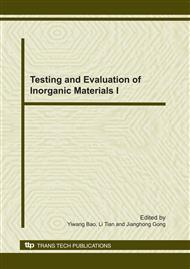p.502
p.506
p.510
p.514
p.518
p.522
p.526
p.530
p.533
Nuclear Magnetic Resonance Studies on Microstructure of Cement Pastes
Abstract:
For water filled porous materials, the difference between the relaxation time of molecules at the pore surface and the relaxation time of molecules in the bulk fluid can be interpreted by a fast diffusion model. With this model, the nuclear magnetic resonance (NMR) can be applied to investigate the microstructure of cement pastes. The cement pastes we tested are two series, one is of same water to cement ratio (w/c=0.4) at different curing time (7d, 28d and 90d), the other is of different water to cement ratio (w/c=0.3, 0.4 and0.5, respectively) at the same curing day. Comparing results by NMR method with those by mercury intrusion porosimetry (MIP) shows that NMR is a convenient and nondestructive way to probe pore distribution of cement pastes.
Info:
Periodical:
Pages:
518-521
Citation:
Online since:
December 2010
Authors:
Price:
Сopyright:
© 2011 Trans Tech Publications Ltd. All Rights Reserved
Share:
Citation:


